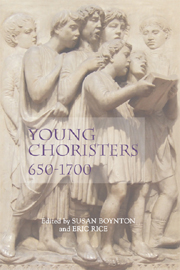Book contents
- Frontmatter
- Contents
- List of Illustrations
- List of Musical Examples
- Acknowledgements
- Dedication
- Introduction: Performance and Premodern Childhood
- 1 The Boy Singers of the Roman Schola Cantorum
- 2 Boy Singers in Medieval Monasteries and Cathedrals
- 3 The Musical Education of Young Girls in Medieval English Nunneries
- 4 Choirboys in Early English Religious Drama
- 5 From Mozos de coro towards Seises: Boys in the Musical Life of Seville Cathedral in the Fifteenth and Sixteenth Centuries
- 6 The Seeds of Medieval Music: Choirboys and Musical Training in a Late-Medieval Maîtrise
- 7 Choirboys in Cambrai in the Fifteenth Century
- 8 Choirboys and Vicaires at the Maîtrise of Cambrai: A Socio-anthropological Study (1550–1670)
- 9 Choirboys, Memorial Endowments and Education at Aachen's Marienkirche
- 10 Thomas Mulliner: An Apprentice of John Heywood?
- 11 Cantando tutte insieme: Training Girl Singers in Early Modern Sienese Convents
- 12 Choirboys in Early Modern Rome
- General Bibliography
- Index
1 - The Boy Singers of the Roman Schola Cantorum
Published online by Cambridge University Press: 12 September 2012
- Frontmatter
- Contents
- List of Illustrations
- List of Musical Examples
- Acknowledgements
- Dedication
- Introduction: Performance and Premodern Childhood
- 1 The Boy Singers of the Roman Schola Cantorum
- 2 Boy Singers in Medieval Monasteries and Cathedrals
- 3 The Musical Education of Young Girls in Medieval English Nunneries
- 4 Choirboys in Early English Religious Drama
- 5 From Mozos de coro towards Seises: Boys in the Musical Life of Seville Cathedral in the Fifteenth and Sixteenth Centuries
- 6 The Seeds of Medieval Music: Choirboys and Musical Training in a Late-Medieval Maîtrise
- 7 Choirboys in Cambrai in the Fifteenth Century
- 8 Choirboys and Vicaires at the Maîtrise of Cambrai: A Socio-anthropological Study (1550–1670)
- 9 Choirboys, Memorial Endowments and Education at Aachen's Marienkirche
- 10 Thomas Mulliner: An Apprentice of John Heywood?
- 11 Cantando tutte insieme: Training Girl Singers in Early Modern Sienese Convents
- 12 Choirboys in Early Modern Rome
- General Bibliography
- Index
Summary
THE first documentary evidence of the presence of boy choristers at Rome occurs near the beginning of Ordo Romanus 1, a detailed description of the papal Mass on Easter Sunday at the Roman basilica of S. Maria Maggiore around the beginning of the eighth century. As the pope approached the altar precinct (presbyterium), the members of the schola cantorum lined up on either side of the processional path.
Then they [the schola] go according to their rank in front of the altar. They stand in order on either side in two rows – paraphonistae on both sides on the outside and the children on both sides in front of them in order.
The rubric assumes that the members of the schola, adults and children, form a “guard of honor” patterned after Byzantine court ceremonial as the papal procession approached the altar for Mass: “et pertransit pontifex in caput scolae.” Recent archeological research suggests the presence of a solea leading to the presbyterium at S. Maria Maggiore. This would mean that the members of the schola lined up on both sides of the space within the barriers, the adult singers standing behind the boys, but the presence of a solea at the time the ordo was compiled is by no means essential. The rest of the rubrics in Ordo Romanus 1 pertaining to the duties of the schola cantorum do not refer separately to the children, and there is no reason to expect that they would do so: the introit was a special case that required precise description.
- Type
- Chapter
- Information
- Young Choristers, 650–1700 , pp. 19 - 36Publisher: Boydell & BrewerPrint publication year: 2008



